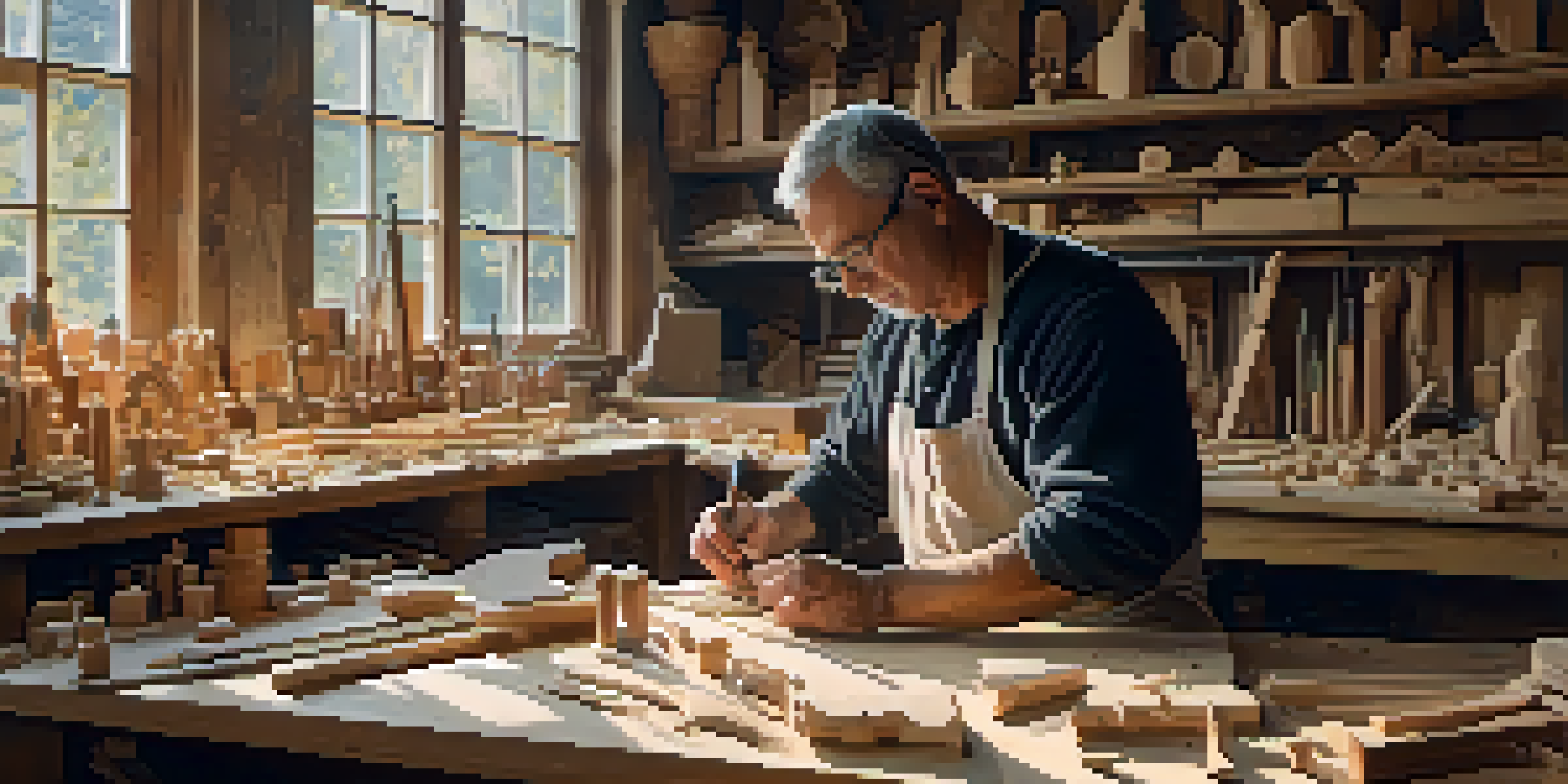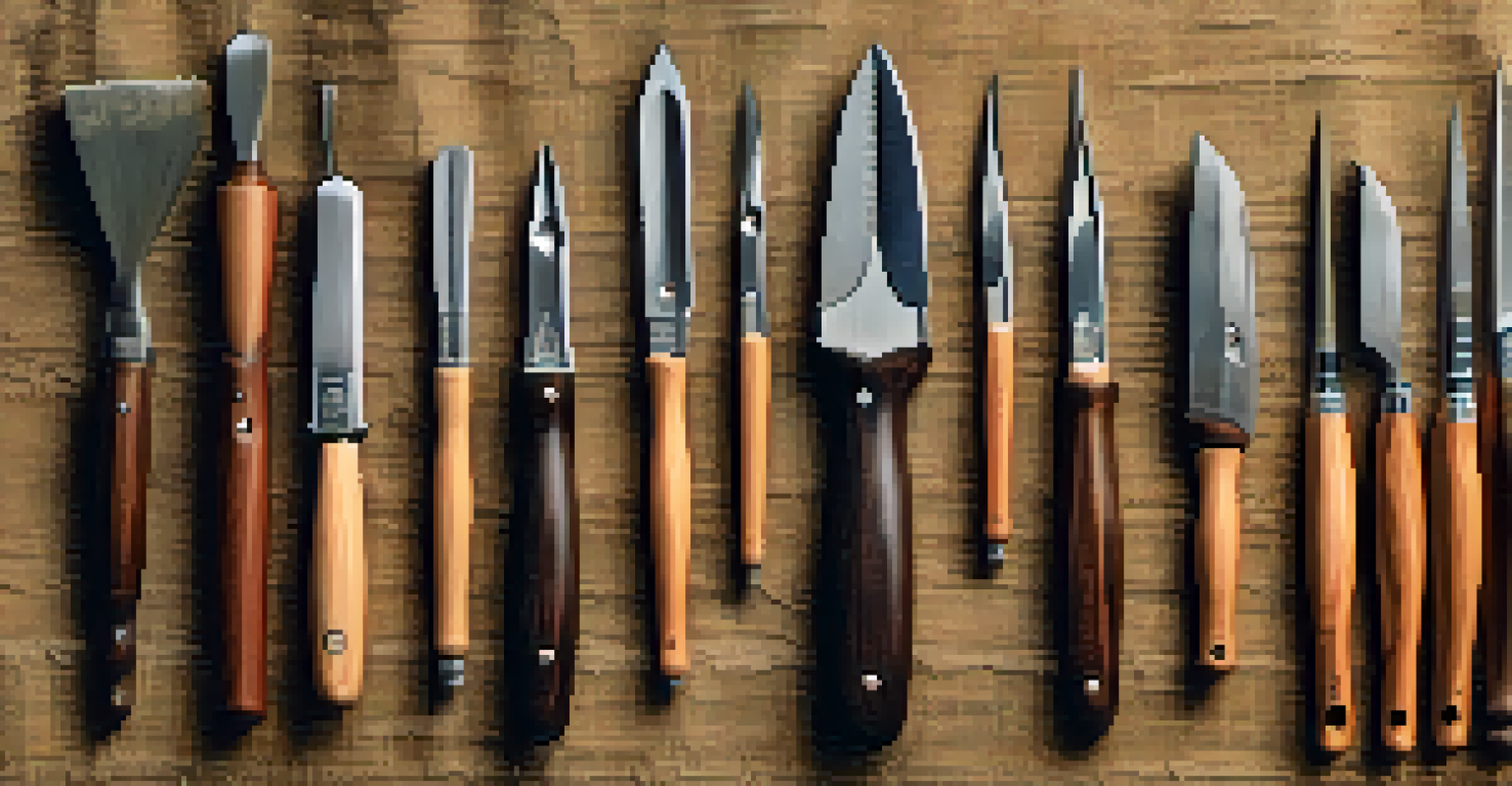Elevate Your Space with Intricate Wood Carving Techniques

Understanding the Art of Wood Carving
Wood carving is more than just a craft; it's an art form that has been around for centuries. This technique involves shaping and sculpting wood to create intricate designs, from simple figures to elaborate scenes. Each piece tells a story, reflecting the skill and creativity of the artisan behind it.
Every artist dips his brush in his own soul, and paints his own nature into his pictures.
At its core, wood carving combines both creativity and precision. Artists use various tools, like chisels and knives, to bring their visions to life. With a little practice, anyone can learn the basics and start creating beautiful pieces for their home.
The beauty of wood carving is that it allows for endless possibilities. Whether you want to create decorative accents or functional items, the only limit is your imagination. This makes it a perfect way to personalize your space.
Choosing the Right Type of Wood for Carving
Selecting the right wood is crucial for successful carving. Different types of wood offer varying levels of hardness, grain patterns, and colors, which can significantly affect the final outcome of your project. Common choices include basswood, butternut, and cherry, each providing unique qualities.

For beginners, softer woods like basswood are ideal. They are easier to carve and allow for more intricate designs without excessive effort. As you gain confidence and skill, you can explore harder varieties, which can produce stunning results but may require more advanced techniques.
Wood Carving: An Artistic Journey
Wood carving is a creative art form that allows anyone to express their imagination through intricate designs.
Ultimately, the wood you choose should align with your vision for the piece. Consider how the wood's natural color and grain will complement your design and existing decor. This thoughtful selection process ensures that your carved item not only stands out but also enhances your space.
Essential Tools for Wood Carving
Having the right tools can make all the difference in your wood carving journey. Basic tools include carving knives, chisels, and gouges, each designed for specific tasks. A well-equipped toolkit allows for greater versatility and precision in your projects.
Wood carving is like drawing with a chisel, a dance between the tool and the wood.
Investing in quality tools is beneficial, especially for beginners. While it may be tempting to opt for the cheapest options, higher-quality tools tend to be more durable and provide better results. They can enhance your carving experience, making it enjoyable rather than frustrating.
Additionally, don't overlook the importance of safety gear. Protective gloves and eyewear can prevent injuries, allowing you to focus entirely on your craftsmanship. With the right tools and precautions, you can carve with confidence and creativity.
Techniques for Intricate Wood Carving
There are several techniques that can elevate your wood carving skills. Some of the most popular methods include relief carving, chip carving, and whittling. Each technique has its distinct style and can be used to create unique designs that can transform your space.
Relief carving, for instance, involves creating a three-dimensional image that stands out from the background. This technique is perfect for creating decorative wall art that adds depth and interest to any room. On the other hand, chip carving focuses on creating intricate patterns by removing small chips of wood, resulting in beautiful surface designs.
Choosing the Right Wood Matters
Selecting the appropriate type of wood is essential, as it influences both the ease of carving and the final appearance of the piece.
As you explore different techniques, you'll discover which ones resonate with your artistic vision. Practice is key, so don't be afraid to experiment and learn from each project. Over time, you'll develop your unique style, making your carved pieces truly one-of-a-kind.
Incorporating Wood Carvings into Home Decor
Once you've created your wood carvings, it's time to showcase them in your home. These pieces can serve as striking focal points, whether displayed on a mantle, hung on a wall, or used as functional items like coasters or bowls. Thoughtfully placed carvings can bring warmth and character to any space.
Consider the overall theme of your decor when choosing where to place your wood carvings. For a rustic look, pair them with natural materials and earthy tones. Alternatively, if your style leans more modern, opt for sleek displays that highlight the artistry of the carving without overwhelming the room.
Remember, wood carvings also make fantastic conversation starters. Guests will be drawn to the intricate designs, and you can share the stories behind each piece. This connection not only enhances your decor but also adds a personal touch to your living space.
Maintenance and Care for Wood Carvings
To keep your wood carvings looking their best, proper maintenance is essential. Dusting regularly with a soft cloth can prevent dirt buildup, which can dull the finish over time. It's also important to avoid exposing your carvings to direct sunlight, as this can cause fading and warping.
For pieces that are frequently used, such as bowls or trays, consider applying a food-safe finish to protect the wood. This can help maintain the wood's natural beauty while also ensuring it's safe for everyday use. Regularly reapplying the finish will extend the life of your carving.
Essential Tools for Beginners
Having quality tools and safety gear enhances the carving experience, making it easier and more enjoyable for newcomers.
Lastly, be mindful of humidity levels in your home. Wood is a natural material that can expand and contract with changes in moisture. Keeping a consistent environment will help preserve the integrity of your carvings, allowing you to enjoy them for years to come.
Getting Started with Your Own Wood Carving Projects
If you're feeling inspired to start your wood carving journey, the first step is to gather your materials and tools. Choose a beginner-friendly project, like a simple relief carving or a decorative ornament, to build your confidence. There are plenty of resources available, including online tutorials and local classes, to help you along the way.
Setting aside time to practice is key to developing your skills. Start with short sessions, gradually increasing the duration as you become more comfortable with the tools and techniques. Remember, every artist was once a beginner, so be patient with yourself and enjoy the process.

Lastly, don’t hesitate to join a community of fellow wood carvers. Sharing your experiences, challenges, and successes can be incredibly motivating and rewarding. Whether online or in person, connecting with others who share your passion can enhance your learning and inspire your creativity.